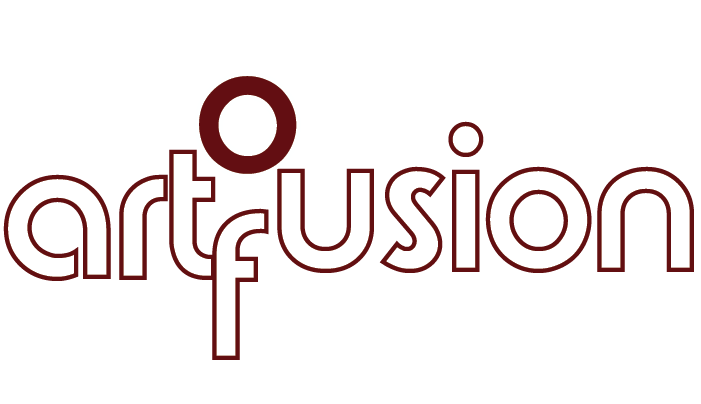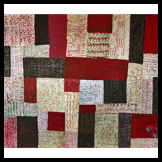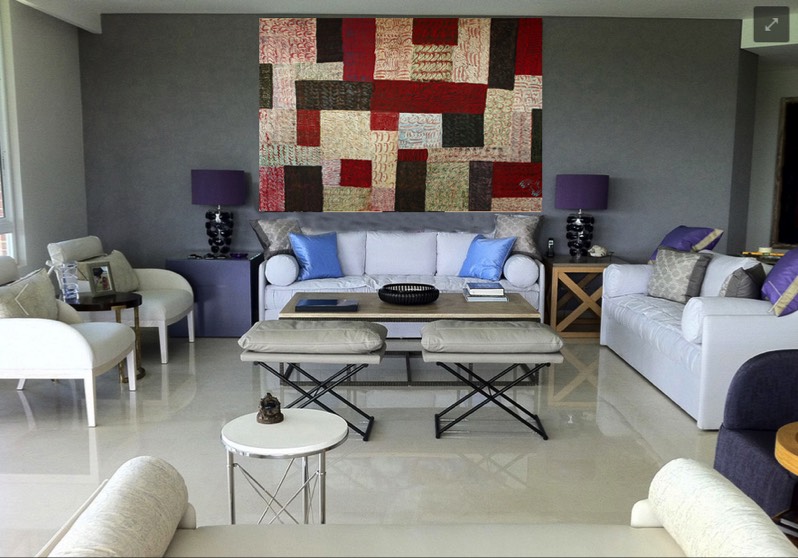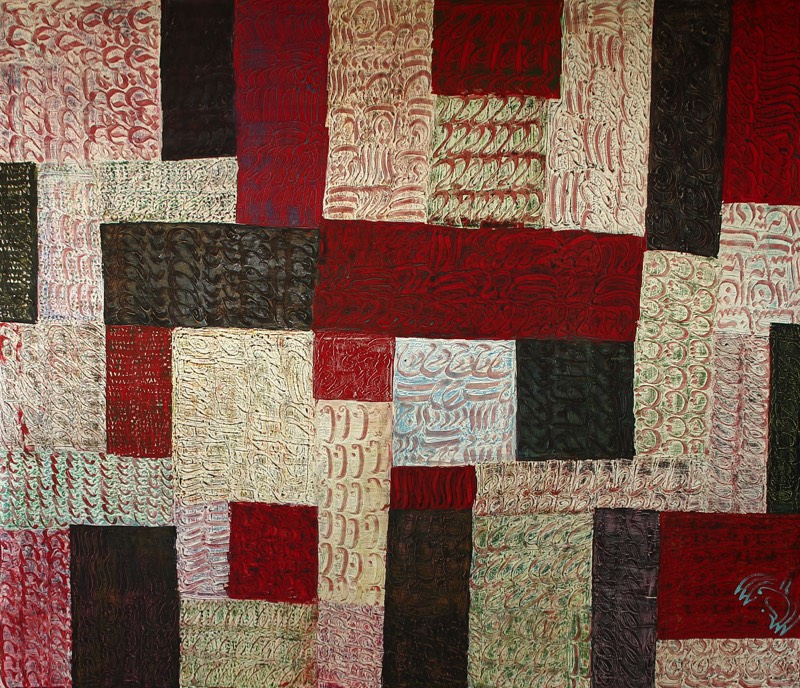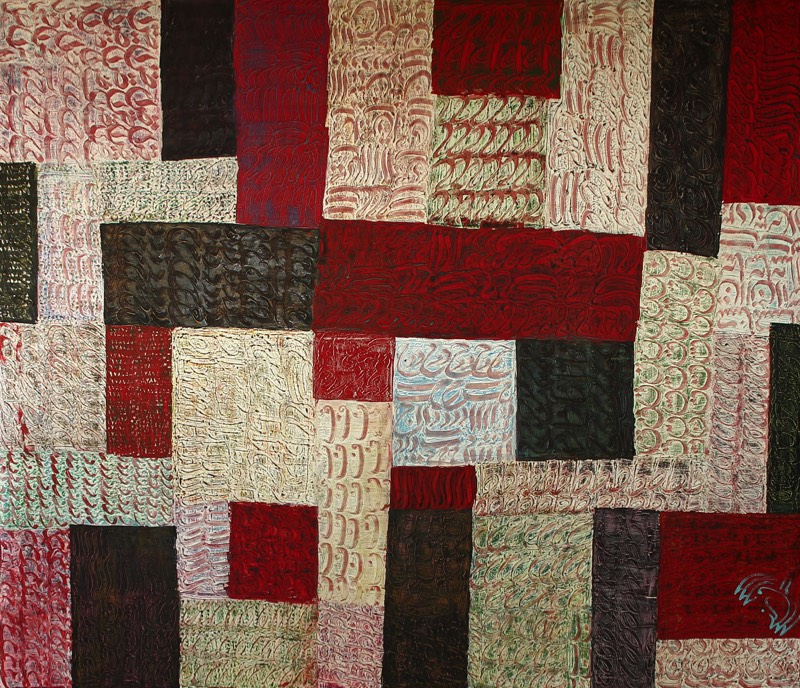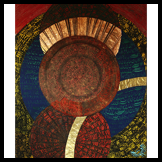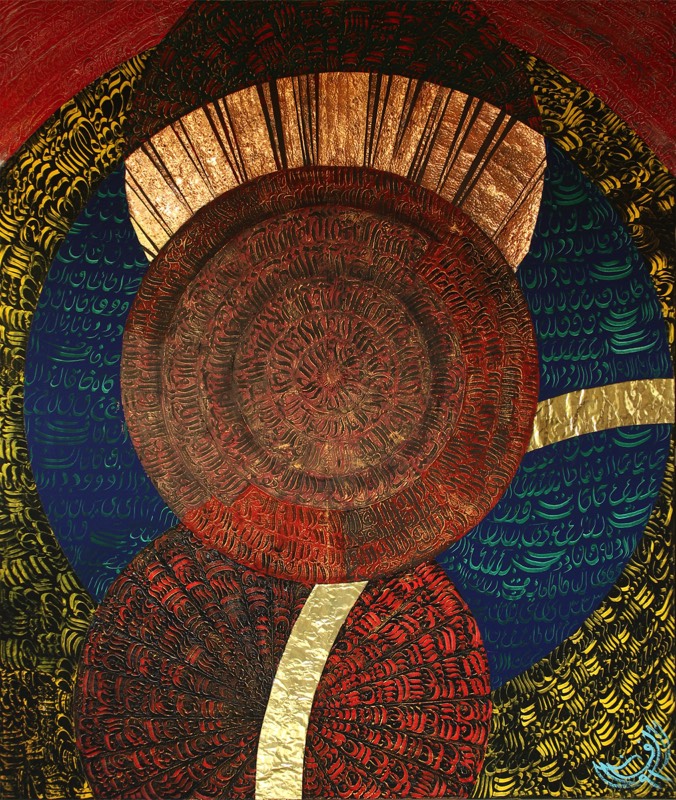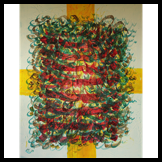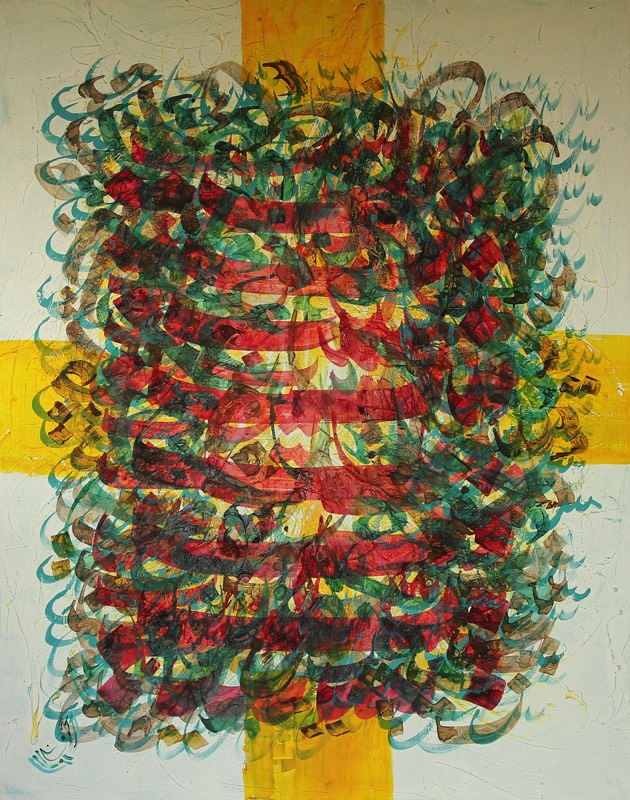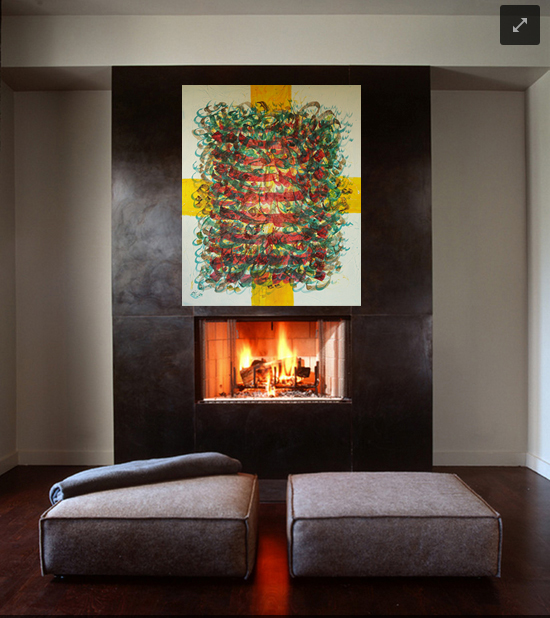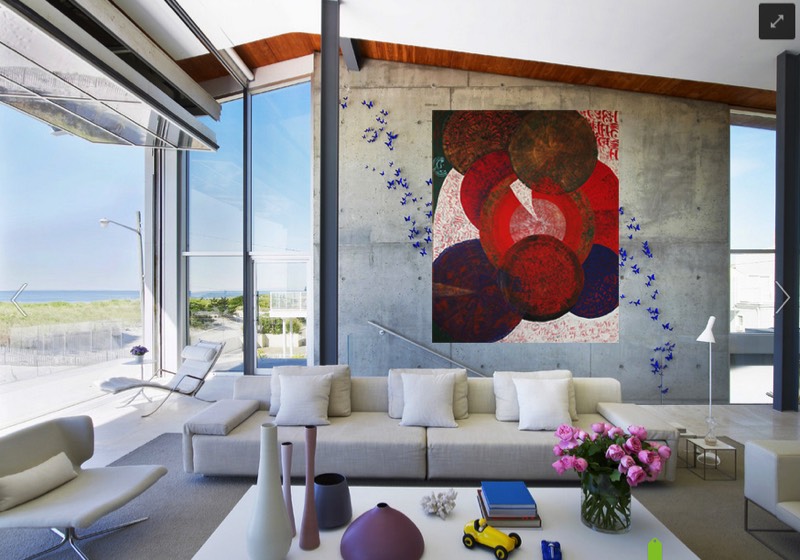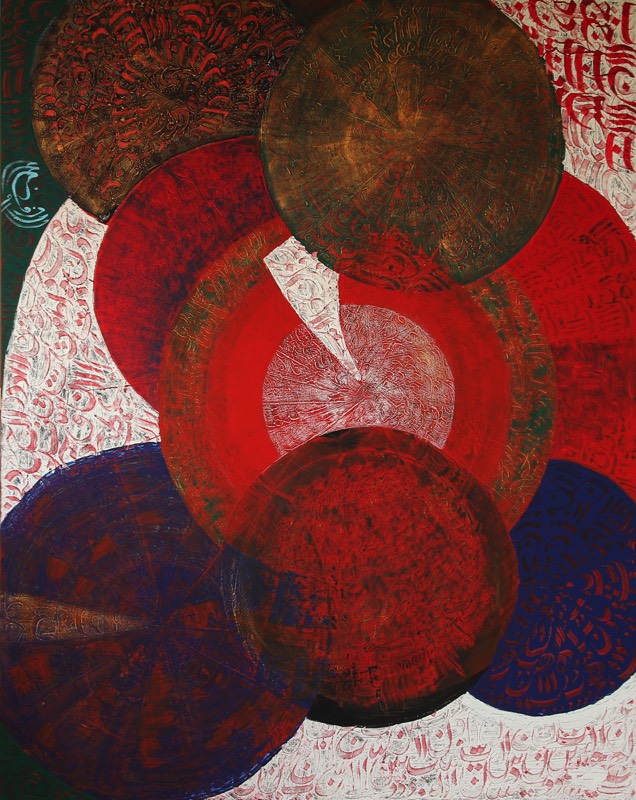Afsaneh Taebi
Artist's Bio
Collection of paintings by Afsaneh Taebi
The Blue Spirit
My mentors:
The virgin nature of Kerman
And the carpet designers of the region
This exhibition is dedicated to:
The Blue Spirit of Shah Nematollah Vali
The Golden Star in Kerman’s geography
•
• Born in Kashan
• Spent childhood in the cities of Qom, Jiroft, Kahnooj, Bam and Sirjan (1966 – 1975)
• Passed intermediary school in the cities of Bijar, Saghez and Kerman (1975 – 1979)
• Passed the high school in Kerman’s Modaress (Guiv) Art School under the guidance of Farkhondeh Abdi (1979 – 1983)
• Learnt calligraphy under the guidance of Mohammad Mirzaee in Kerman (1983)
• Learnt photography under the guidance of Masoud Zendeh Rouh Kermani in Kerman (1984)
• Took an animation course and worked in the Children’s Group of Kerman TV in Kerman (1984)
• Took a BA in handicrafts from Al Zahra University in Tehran (1985 – 1992)
• Learnt metalwork under the guidance of Master Dehnavi
• Wood inlay: Master Zaboli, Gilding: Master Bagheri
• Fabric printing: Master Ganjineh, Photography: Master Siah Ghalam
• Miniature: Master Ali Moti’e
• Passed a three-year session on Iranian Miniature Schools under the guidance of Master Moti’e, Tehran (1995)
• Taught painting in the Shokofehaye Enghelab Kindergarten, Tehran (1986)
• Participated in Japan’s Asahi Simbon Exhibition. Won the Jury’s Special Mention Awards and the Exhibition Book, Tehran 1987
• Submitted the University Thesis on “Biography of Hassan Khan Shahrokho, the famous Painter and Astronomer of the end of Qajjar and the Beginning of Pahlavi Era” research and study of Kerman Carpet in the last 100 years under the guidance of Dr. Ebrahim Bastani Parizi
• Illustrated the works of the new trend poet Sohrab Sepehri in the form of Iranian miniature under the guidance of Jamaluddin Khorami Nezhad
• Used the poem cum painting technique under the guidance of Ali Moti’e, Tehran (1992)
• Prepared the collection of photos from Caravanserais, the Bazaar, alleys, houses and the people of Kerman, Kerman (1993)
• Prepared the collection of photos of social Tehran, Tehran (1990)
• Participated in the first painting biennial, won the Commendation Plaque, runner up of the Jury’s Special Awards, Tehran (1993)
• Taught drawing in the Shahid Avini Art School for Girls (2003)
• Participated in the second painting biennial, won the Commendation Plaque, Tehran (1995)
• Participated in the third painting biennial, obtained the participation certificate, Tehran (1997)
• Solo exhibition in the Haft Samar Gallery, Tehran (1992)
• Was invited to participate in the Iran – Austria Cultural Week, Austria (1997)
• Taught in the Azadegan Art School for girls, Tehran (1998)
• Learnt lacquered pen-holder making in bird and flower patters under the guidance of Master Soleimani, Tehran (1999)
• Was invited to cooperate with the Cultural Memorials Foundation as the Manager of the Saadabad Gallery, (2000 – 2003)
• Was invited to cooperate with the Niavaran Palace of the Cultural Heritage Complexes as the Manager of Jahan Nama Gallery, Tehran (2001 – 2003)
• Organized the Capet Festival, in the Blue Hall of Niavaran Palace, Tehran (2001)
• Organized the World Children Day Event with the assistance of the students of the Islamic Open University, Tehran (2002)
• Organized a festival of painting, theater, puppet show, field games and pottery for children for the benefit of MS patient in the Niavaran Palace grounds
• Managed the organization of the Festival of Iranians the Torch Bearers of Ancient Heritage, Second Year, Tehran (2003)
• Organized art auctions each fortnight for a consecutive period of 2 years combined with street theater in the Cultural Heritage Complex of Niavaran Palace, Tehran 2003
• Was invited to participate in the group exhibition of Master Moti’e’s students in the Saba Cultural Center, Tehran (2003)
• Was invited to participate in the group exhibition of Ladies of Iranshahr School in the Clara Abkar House of Saadabad Palace, Tehran (2001)
• Cooperated with newspapers, periodicals with a series of articles and radio-television interviews on the role of art in public life
• Wrote 8 books of poems and love and Gnostic sonnets, Tehran (2004 – 2006)
• Research and study on prayers and the impact of letters and numbers, as well as the science of letters and numbers and their interpretation for painting and illustration, Tehran (2003 – 2007)
• Painting on ceramic, the collection of earthenware plates and necklaces under the guidance of Reza Taebi, Tehran (2006)
• Participated in the painting exhibition of “seven views, annual sale” in the Niavaran Cultural Center
• Selected artist among the three top artists with the greatest works sold during the first day of exhibition, Tehran (2007)
• Solo exhibition at Mrs. Mariam Fasihi Harandi’s Place, Tehran (2008)
• Solo exhibition at Mrs. Zahra Harandi’s (Barkhordar) Place, Tehran (2008)
• Solo exhibition at Mrs. Azita Rahnama’s Place, Tehran (2008)
• Solo exhibition for the benefit of Hazrate Zeinab Charity Orphanage, Tehran (2008)
• Solo exhibition of Thousand and Einn Iran in German at Kerlsrube (2009)
• Collective exhibition, Calligraphy painting at Shams Art Gallery (2009)
• Collective exhibition, Calligraphy painting at Haft Samar Art Gallery (2009)
• Solo exhibition, Calligraphy and painting at Faryad Art Gallery Iran, Kerman (2010)
• Solo exhibition, Calligraphy and painting at Arte Gallery Iran,Esfehan (2011)
• Solo exhibition, Calligraphy and painting at Arsh Gallery Emirates,Dubai (2012)
The present collection is the result of 4-year effort of the artist and her interpretation of the impact of letters on spectators
Art is created
To make us see and understand a
better, more beautiful, more attractive,
happier, at times though provoking and broader World.
At the beginning, writing made it possible to record events. According to history, the Phoenicians were the first to invent writing, to which history owes its survival. Love sonnets, the literary sciences and techniques, life’s secrets and the adages of philosophers and the prophets who were the spiritual teachers, as well as the scientific and landmark discoveries and inventions, royal decrees, cultures and art recorded for future generations have all been preserved by writing. At a time when there were no means and technologies for storing information, the only custodians and guardians of the human experience in all fields of science, culture and politics, and the sole purveyors of knowledge throughout the world were books, words and scripts. Through written words we return to the ancient times and through words, we open a window to the present era for the future generations. Words and signs are the sole recorders of time, and through reading we are able to visualize images that bring the past to life. Are stories told by such great literary figures as Shakespeare, Dante and Mowlana anything but words? It is only words that convey feelings to us. You use words to tell your friends you love them, and the spiritual guides use words to teach their disciples the secrets and finer meanings of life. Words are made of letters, and letters are symbols of sounds that are the building blocks of speech, i.e. each letter represents a sound. The symbol of words ends up in sounds and the repetition of each word in mind or the subconscious entails the awareness of the word in the spirit, which leads to the better consciousness of the individual. From a psychological perspective, if a person keeps repeating the word beautiful, beautiful, beautiful, this word makes him/her believe that he/she is indeed beautiful and this repetition turns the person into a kind and attractive being.
The word beautiful is made up of letters b, e, a, u, t, i, f, u and l, but these letters hold images of innumerable beauties in them, and by repeating, a person creates his/her own perception of the idea. Therefore the power of words is a magical one, by which all prophets and philosophers have been able to change ideas. Thus each letter and word plays a significant and key role in creating the structures of ideas and in conveying concepts.
Words in the calligraphic images of the painter “Afsaneh Taebi” are the symbols of the beauty that exist within them, and have been created in the canvas through a combination of letters and colors to bring forth good, benevolence, happiness and love.
The Names of God mean the higher traits of the existence that are attributed to God or the Superior Being, in the frame of words, to enable humans to transform them into their chief ideas through repetition and to establish designs of serenity in themselves, through these very same words.
These paintings are formed by the repetition of a word or letter and colors. In fact the repetition of a word or letter has been designed in such a manner as to create a link with the concepts of the Names of God, the Names of Good. In the Iranian Culture, words were uttered as a protection against evil and for the invocation of good. The repetition of these words is the daily reminder and a repetition for the praying devout leading to the inner purity.
Pondering on the importance of prayers and nurturing the spiritual self have constantly taught by practitioners of meditation and the spiritual guides. The combination of color and letters in the images of the painter, can, for the viewer, be a daily reminder of significant concepts, which are contained in the heart of a word or a letter, and which regulate the spiritual structure of the spectator. However, the colored patterns and forms and the frames created in the work lead to a greater consciousness of the individual, and the wider influence of the words draws up a sacred environment for the spectator, and has therefore been designed with the intention of fixing the word in the mind of the viewer. Each region has its own sounds and words for conveying ideas, which are the results of its particular environment and surroundings. Words can even carry feelings, scents, colors and sounds to reconstruct them once again in minds. Like music, the sounds and the words of each territory are particular to the land and different from any other. However, each land has an alphabet and by combining and displacing letters, the people of the land obtain the conceptual structure of their words. Furthermore, the letters’ signs in each territory have their own special forms, which are linked to the images of the land, the relations and the different senses in the individual minds. Concepts and colors have also their own particular signs, and all colors are derived from the white light. Indeed these rays are not only available on earth, but also higher up and in the universe. They are constantly pulsating and surround the earth in the form of an infinite and inexhaustible energy. In the same manner as these radiations and energies (macrocosms) surround and infiltrate the earth, an energy called microcosm surrounds and penetrates the human body, going down from the left and negative side to come up from the right and positive side of the body. These great light waves are the real sources of our strength, and each has a particular as well as a general role and purpose. Each individual is born under the influence of a special color, while at the same time remaining under the effects of secondary spectra as well. The focal point of color spectrum and waves is made up of an aura. Aura is a radiating light encircling all creatures. I reiterate that we are constantly surrounded by colors, and colors are the cosmic energies and the wonderful power of life.
From beyond, color affects each of our nerves, cells, glands, muscles and sparkle in our aura to radiate our environment. Colors are sacred and affect our spiritual rays. Each letter radiates according to its own special color spectrum. Combining letters and colors to enhance the impact on spectators, is a technique used to create the works that you witness.
